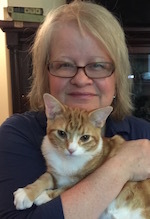4 Tips for Mixing Truth With Fiction
 Vicki Vass, @vickivass
Vicki Vass, @vickivass
Whoever said reality can be stranger than fiction might be right, at least for me. Reality slips into my cozy mysteries, particularly my Antique Mystery Hunters series. My need to insert reality into my stories might stem from my long experience as a journalist.
When I set out to write my first mystery, I studied Writer’s Digest to learn about the structure, settings and particularly the characters. The magazine advised that characters should be amateur sleuths with a hobby that lends itself to detecting. The creative juices began flowing thinking of ideas. I had no one particular hobby other than reading so I thought and thought until I thought about the antique hunting expeditions. Being in a new to me home, I had spent the past year antique hunting with my two best friends. We would venture to barn sales, flea markets, antique stores and everything in between.
My two characters quickly developed, CC Muller, a journalist who is the encyclopedia of knowledge, and Anne Hillstrom, shopping collector and antique enthusiast. They quickly became the protagonists of my Antique Hunter Mystery series.
Many of their real-life escapades make it into my novels, including a recent setting within a cemetery after the real-life CC found herself locked in a Chicago area cemetery one evening when the caretaker left early. The real version gave way to a scarier more suspenseful version that leads the plot along.
That is how I’ve merged truth with fiction in my series, here are four things I’ve learned along the way about using reality within my fictional stories.
Ask for permission. After I wrote the first book, Murder for Sale, I gave my friends copies and asked them to read it. They were flattered with the content and that gave met the freedom I needed to further develop the characters. I have also subsequently asked them before including bits of real life such as the cemetery scene.
Observe and listen: When I go out, I like to sit and listen to conversations around me. It helps me create realistic dialogue. Now when I am with my friends, I listen to their anecdotes and picture my characters. As in the cemetery scene noted up above, I might not have had the idea to include it if I hadn’t listened to my friend’s story.
Change it up. While my characters may be based on real people, there are definite differences. I have changed their names for the sake of the story. My fictional characters do not physically resemble the real individuals. They have kept some of the main character traits but over the series the fictional characters have transformed taking on traits of their own.
Edit. Don’t be afraid to take out a detail or change something. Sometimes the truth can be mundane or boring. As a former journalist, I had to let go of my need to report on reality or the truth. Instead, I’ve enjoyed the freedom of expanding on real-life actions and sometimes making them bigger than life. And, when it’s not working don’t be afraid to edit it out. One scene based on a real event just wasn’t working within the flow of the story. I felt as if it was slowing down the pace. Finally after much deliberation I removed the scene. Who knows? Maybe it will show up in a future Antique Hunters book.
Thanks for letting me stop by and share a little about my series. Fellow writers, I’m curious, do you find reality creeping in your work? And, if it does, how so?
 After turning in her reporter’s notebook, Vicki Vass turned to chronicling the near-real adventures of her two best friends in the Antique Hunters Mystery series. Book 6, A White Rabbit’s Tale, will be released in December. She chronicles her real-life adventures and reads on her blog, Vicki’s Cozy Corner (vickiscozycorner.com). Fleeing from a Chicago blizzard, she now lives in the foothills of the Blue Ridge Mountains with her husband, two Australian shepherds and cats who star in her Witch Cat Mystery series.
After turning in her reporter’s notebook, Vicki Vass turned to chronicling the near-real adventures of her two best friends in the Antique Hunters Mystery series. Book 6, A White Rabbit’s Tale, will be released in December. She chronicles her real-life adventures and reads on her blog, Vicki’s Cozy Corner (vickiscozycorner.com). Fleeing from a Chicago blizzard, she now lives in the foothills of the Blue Ridge Mountains with her husband, two Australian shepherds and cats who star in her Witch Cat Mystery series.
Tips for Mixing Real Life with Your Fiction from @vickivass :
Click To Tweet
Photo on Visual Hunt
The post 4 Tips for Mixing Truth With Fiction appeared first on Elizabeth Spann Craig.



